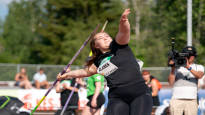Anni-Linnea Alanen’s sixty is a boost that the domestic women’s javelin throw has needed for years. Alanen’s challenge is still the fluctuating level within the Games, writes journalist Atte Husu.
Atte Husu Sports reporter
The women’s race at Pihtiputa’s javelin carnival has not enjoyed significant media attention for years. The reason for that has been clear.
The domestic women’s javelin throw has been plowing for a long time in readings starting with five, so the organizers have had to rely on foreign throwers when marketing the event.
At Midsummer, however, budding expectations were set in the spear circles, when Anni-Linnea Alanen broke his record of 59.69 at the EC team championships.
Still, many could hardly have predicted what kind of shot from the 20-year-old Oulu Pyrinnön thrower would be seen in the cradle of the traditional sport in Pihtiputaa.
Alanen’s final round throw of 62.45 is the best Finnish result in eight years and the best thrown by a Finn at the carnival since 2004. At that time Paula Tarvainen nailed his javelin to 62.63.
62.45 takes Alane to tenth place in the world statistics of the current outdoor track season and second place in the EC statistics for under-23s. The latter metric is more important than Alanen’s tip, because his main goal of the season is the Espoo under-23 European Championships starting on July 13.
Basic level still a question mark
Alanen’s 62-meter throw is a much-needed boost to the domestic women’s javelin throw, but also, above all, a significant milestone for the athlete herself.
Alanen’s abilities have been known for a long time. He made headlines in 2019 – even then in Pihtiputaa – by throwing 55.24 at the age of 16. It is a Finnish record for under-18s. Two years ago, Alanen was only 48 centimeters away from the 60-meter mark in the best of the summer.
Against this background, the spike throwing seen on Sunday has existed, but the end result was quite different for a long time.
Alanen’s biggest challenge has been the huge fluctuation in performance. It is partly due to several episodes of illness.
In the summer of 2021, the range of competition results was 48–59 meters, and last season it was 45–57 meters. In the last two Kaleva competitions, the results have been something between 57 and 45 meters.
Although in the javelin throw only the best throw is asked, there has been no information about the pile that best describes the athlete’s level in Alanen’s case. Before this season, Alanen had not thrown a single competition in which more than half of his throws would have carried more than 55 meters.
Alanen succeeded in the aforementioned trick in his first and third races of the current season.
Although the next three races have provided two records, the vast majority of race throws have fallen below 55. That was also the case on Sunday, despite the world-class result.
Routine is the key to success
Sunday’s result put Alanen in tenth place in the world statistics. He is behind the pitchers ahead of him, especially at the base level.
This season, 34 throwers have exceeded 60 meters. If their basic level is considered based on the average of four or five races, Alanen fits right into the top 20.
In the women’s javelin throw, a generational change is taking place right now, as the reigning European champion among adults is Alanen’s peer Elina Tzengko. Based on the statistics, the Greek, who threw 63.65 this season, is Alanen’s main opponent in a couple of weeks at the under-23 European Championships.
If the eyes are directed further from Espoo’s EC home games to the end of the summer, the 19-year-old would be an excellent comparison in terms of Alanen’s development Adriana Vilagoš. The Serb, ranked 14th in the world statistics, is the reigning under-20 world champion, whose placard also includes the European Championship silver for adults from last August.
Vilagoš has broken the 60-meter barrier three times this season, but his reliability (5-race average 60.57) gives a seam to the long javelin throw.
Sunday’s result is significant for Alase above all mentally. A top throw like Pihtiputaa is enough to get high in any race, but repeating it is a challenge if the repeatability of throws between races and above all within races is at the current level.
In order for Alase to develop into an international level success in the adult series in the next few years, making piles like Vilagoš would be more important than individual top throws.
